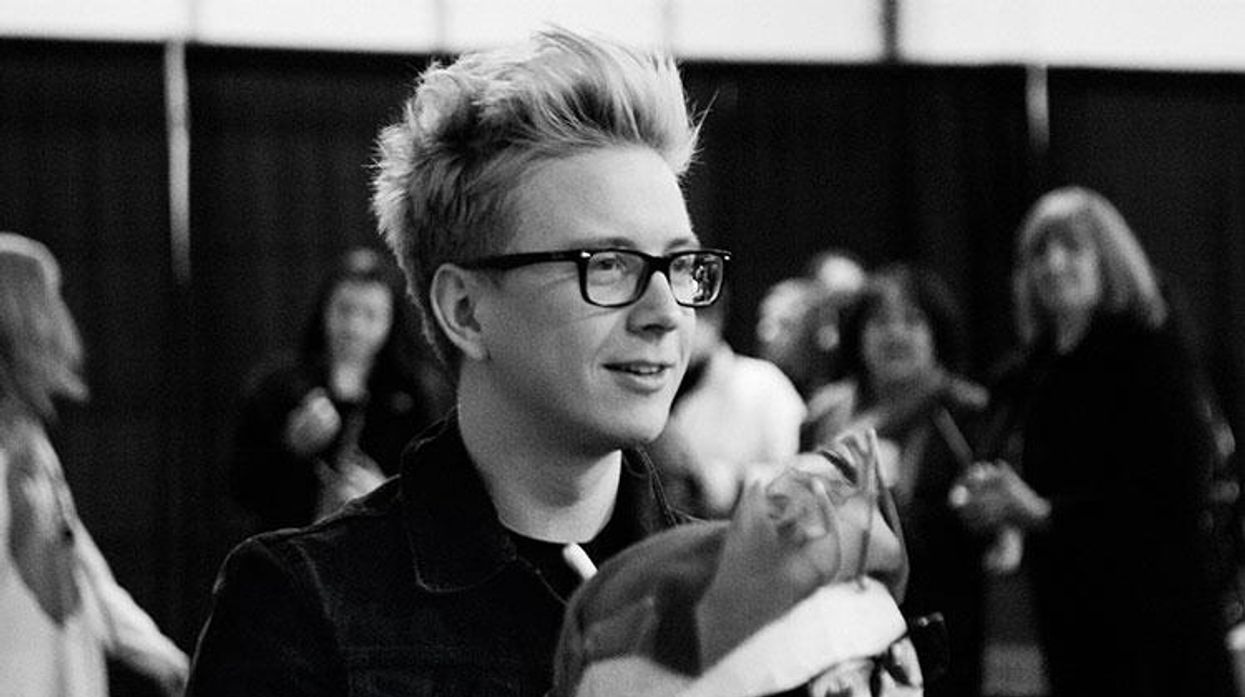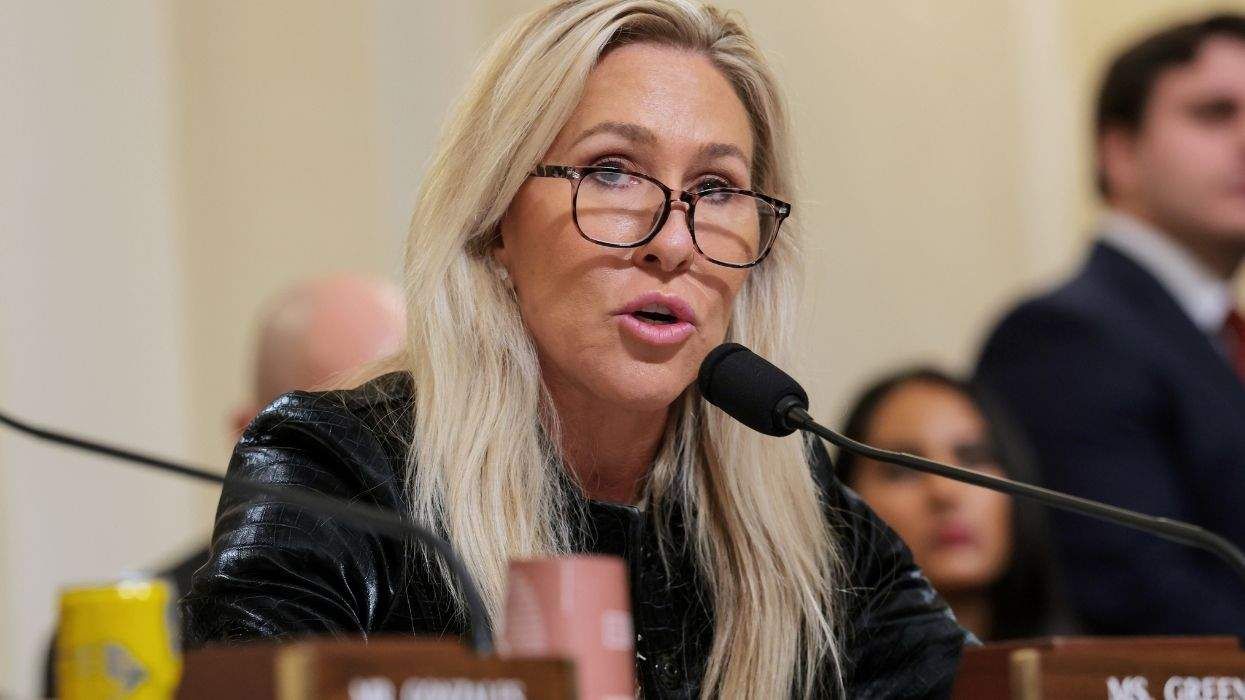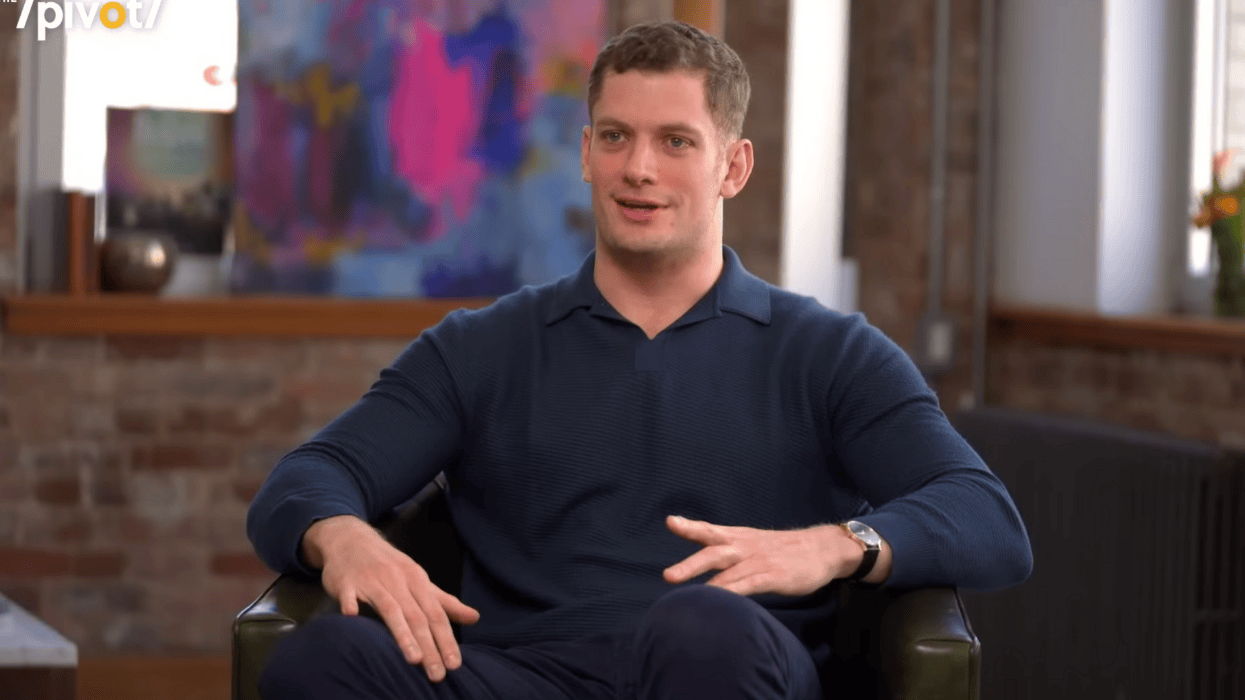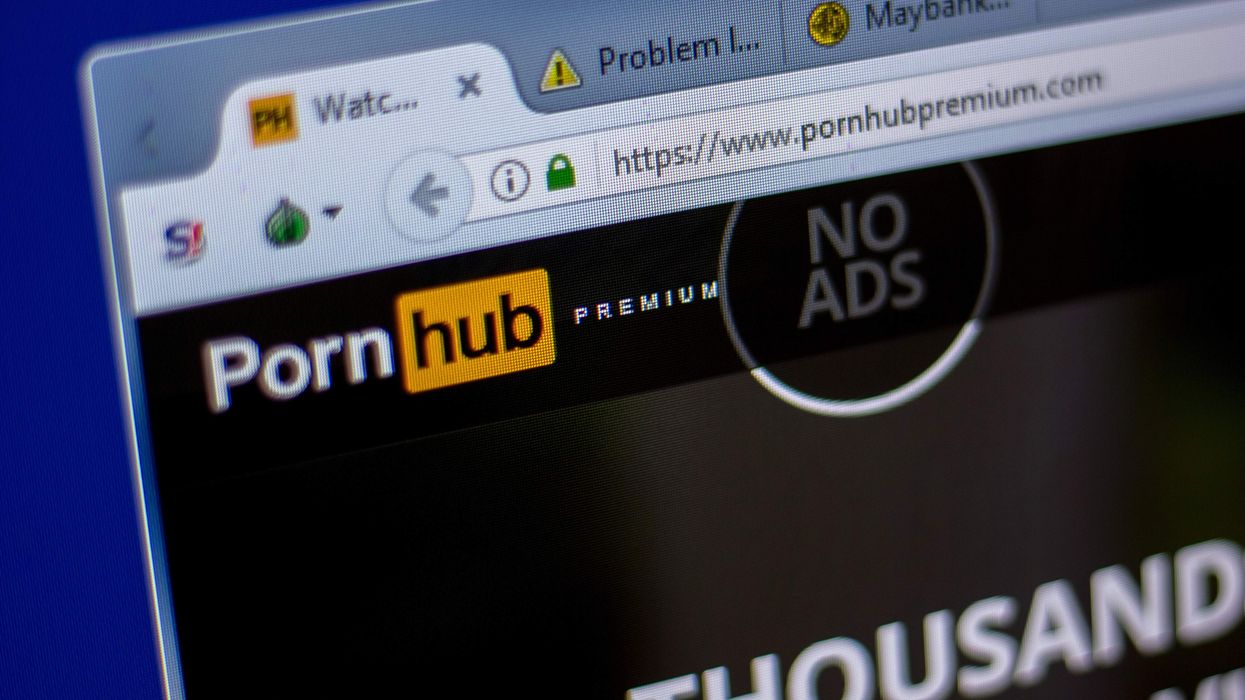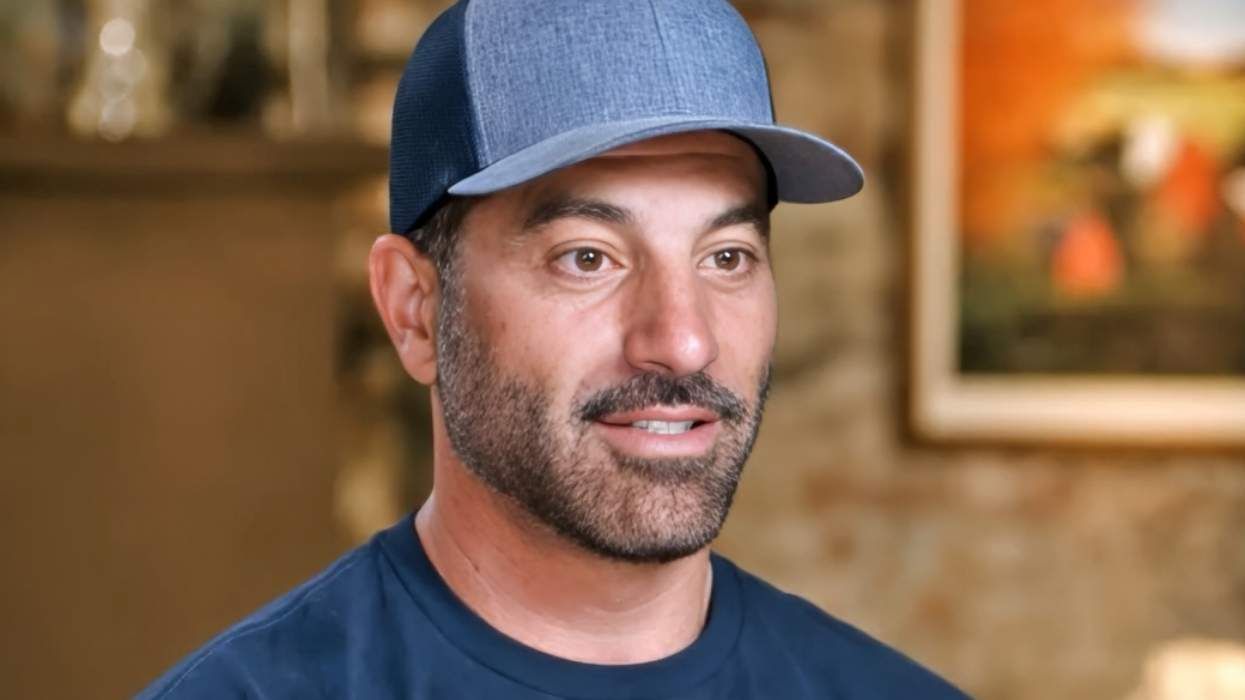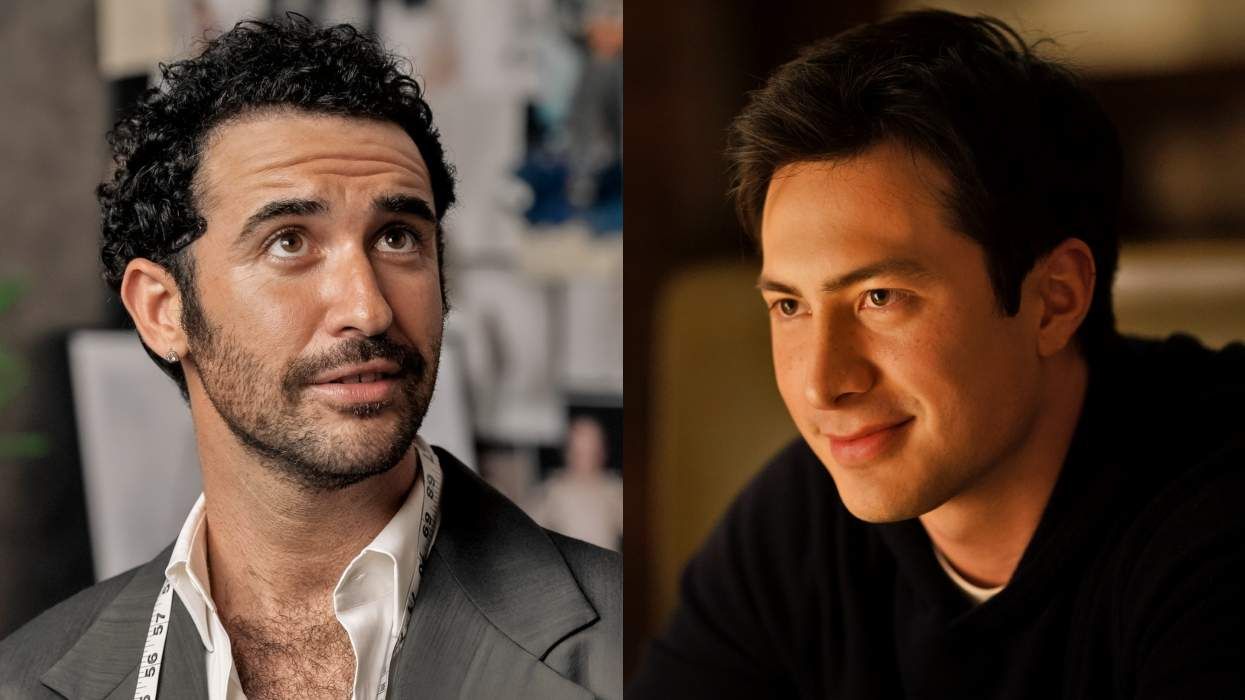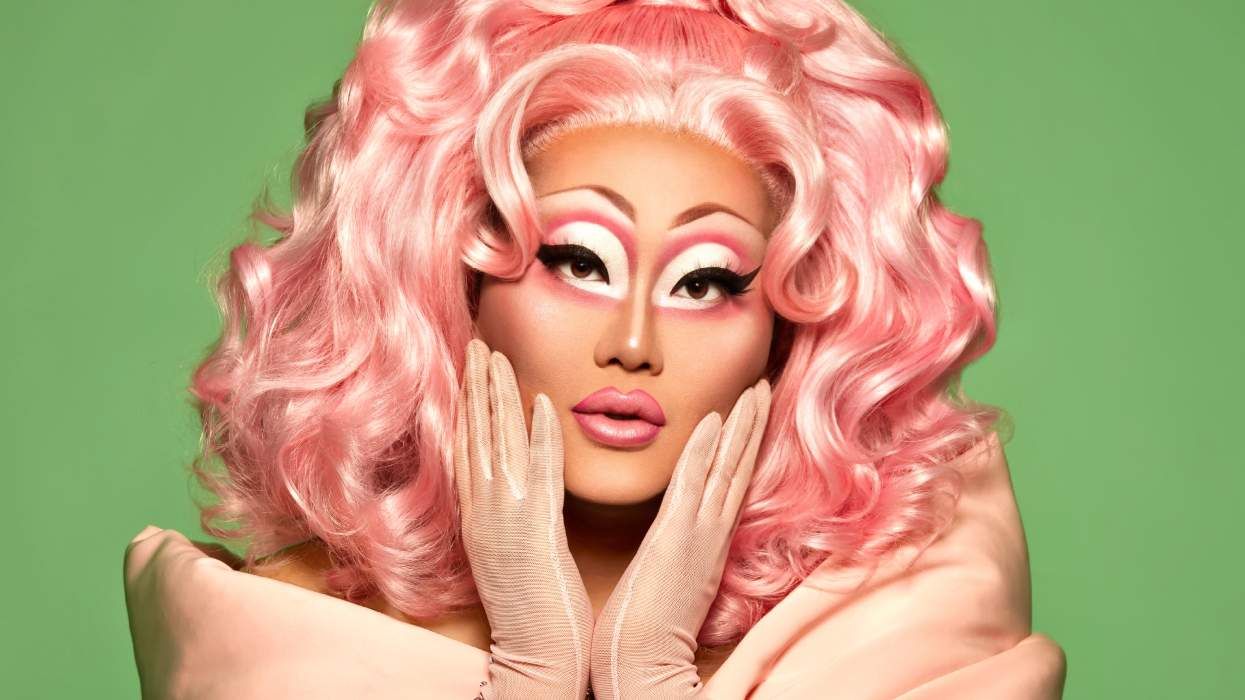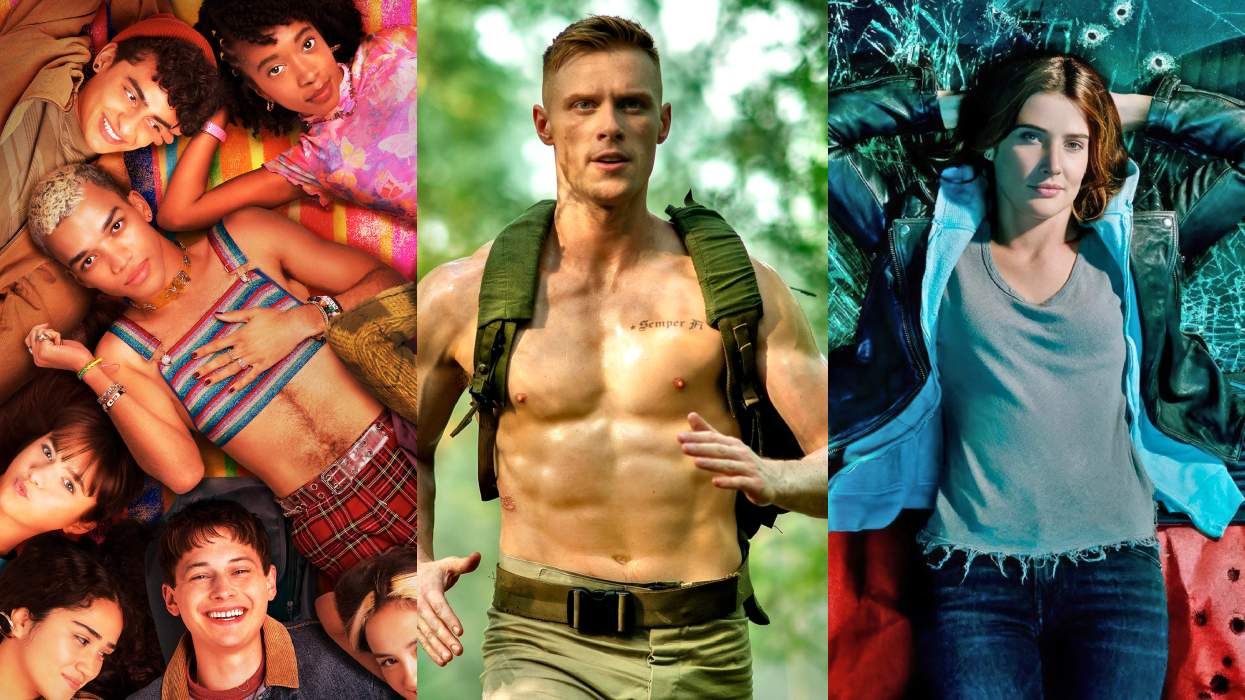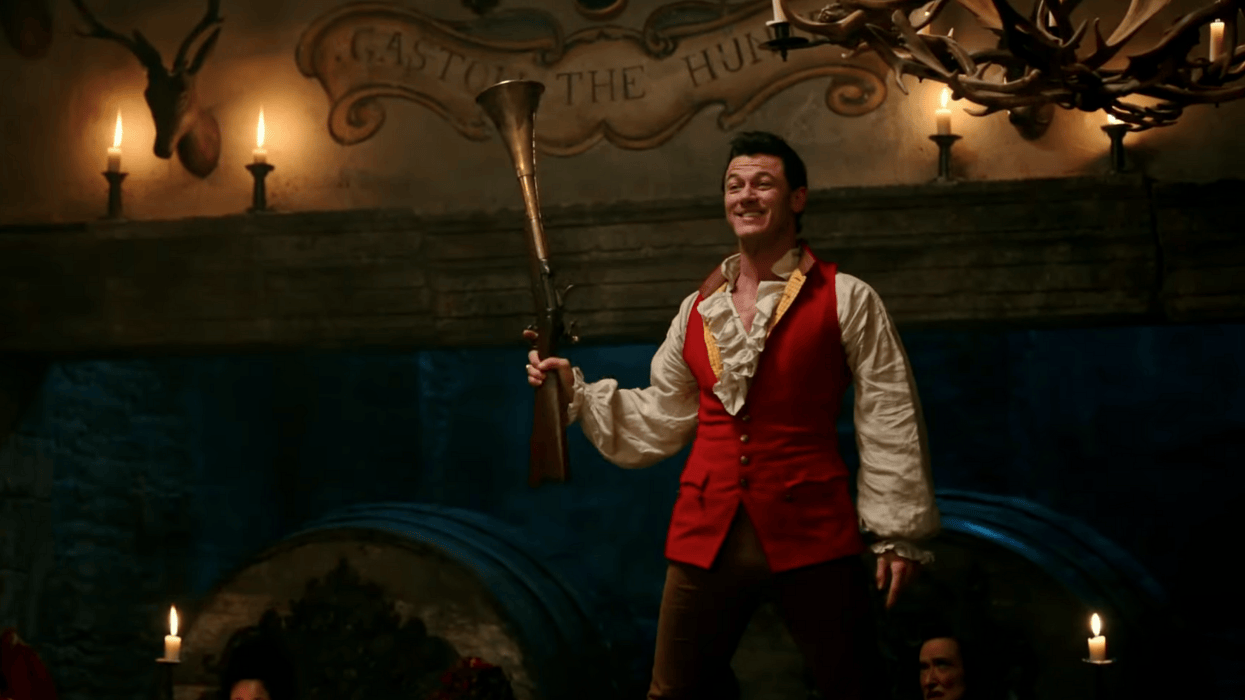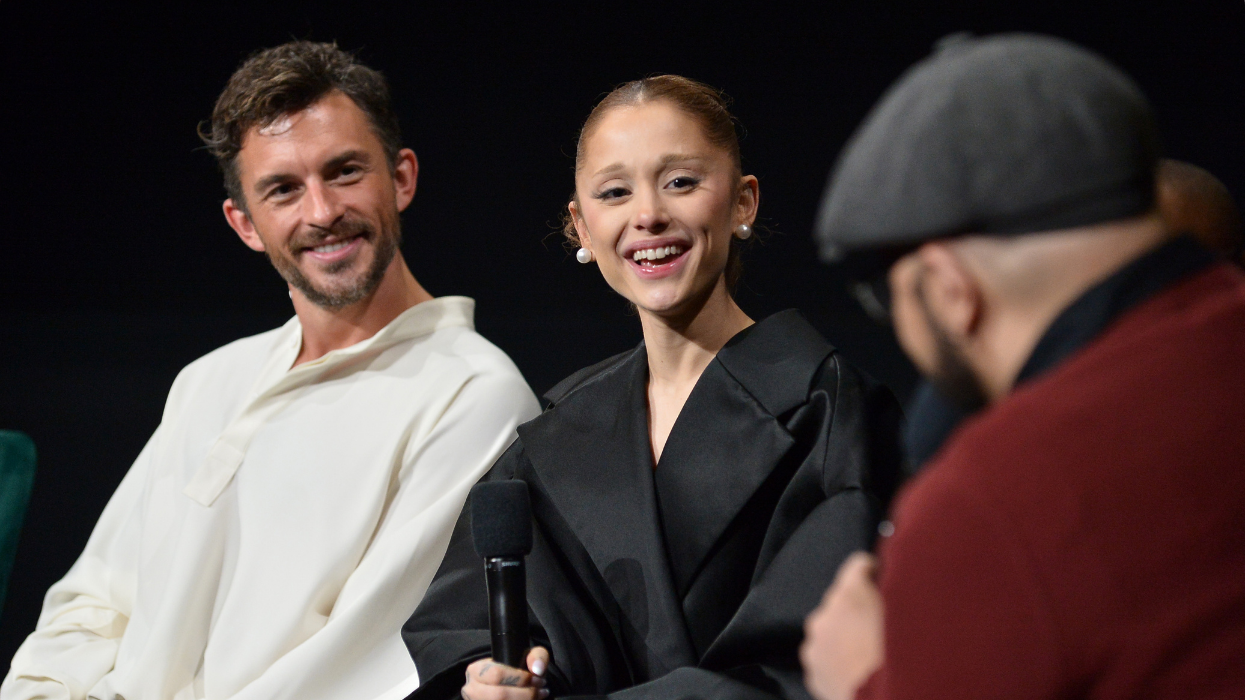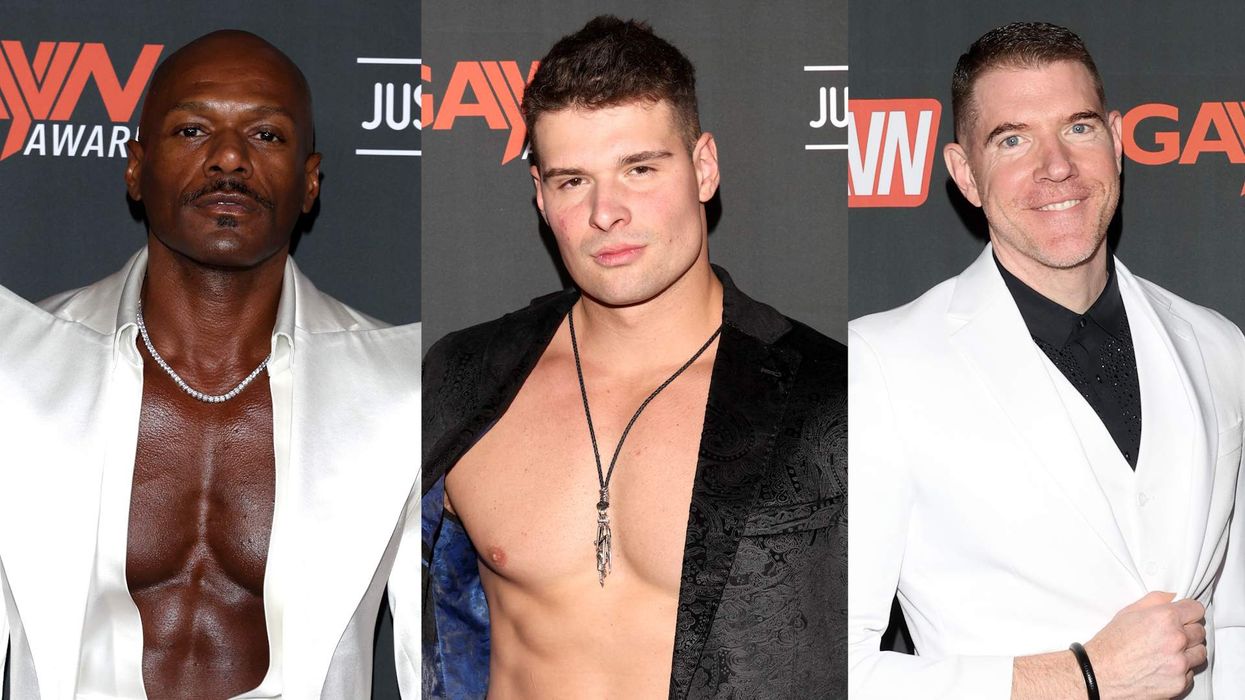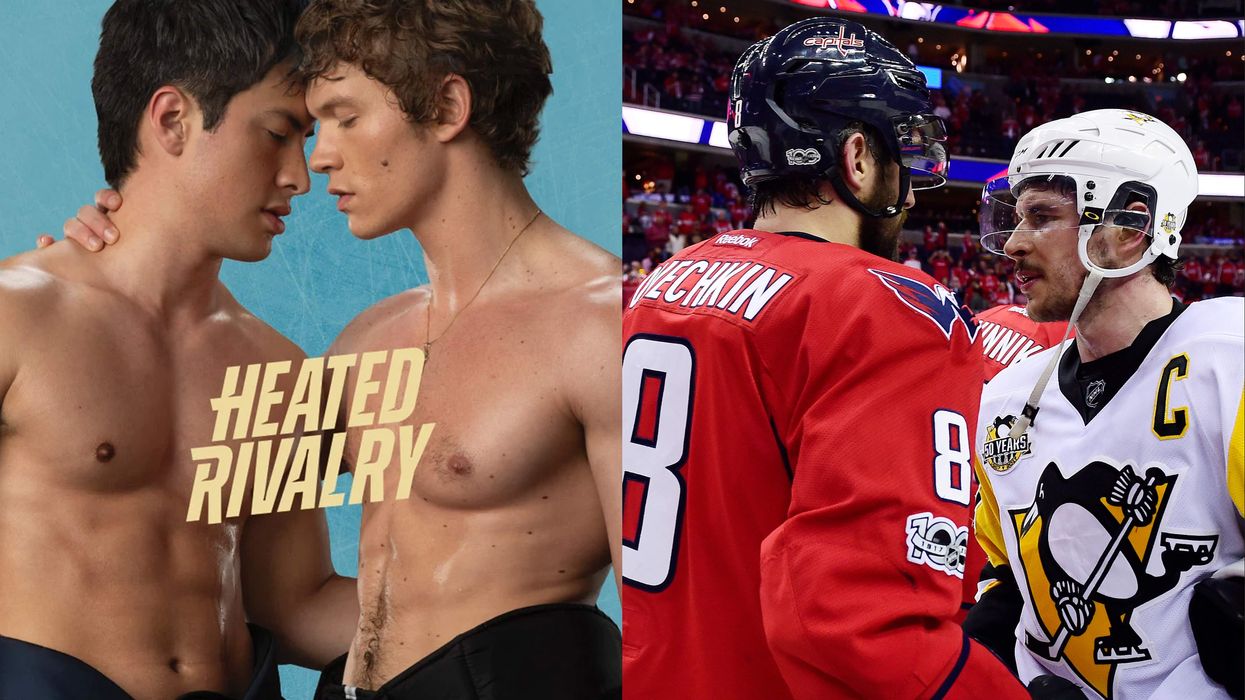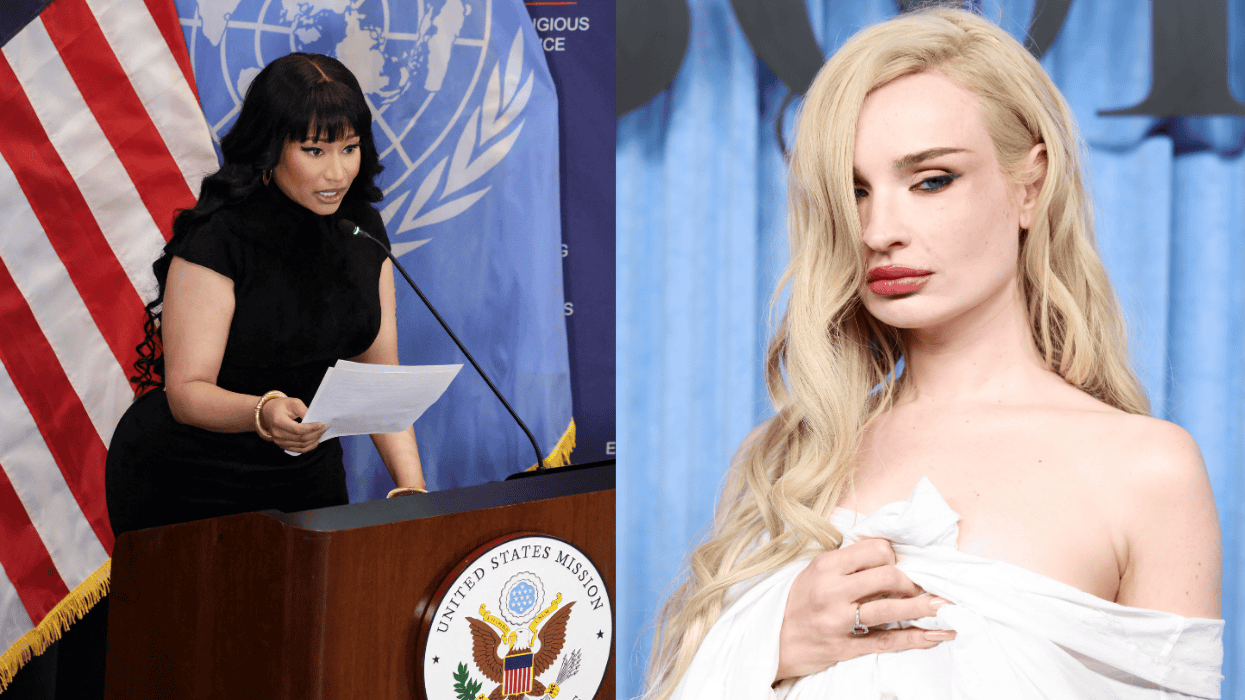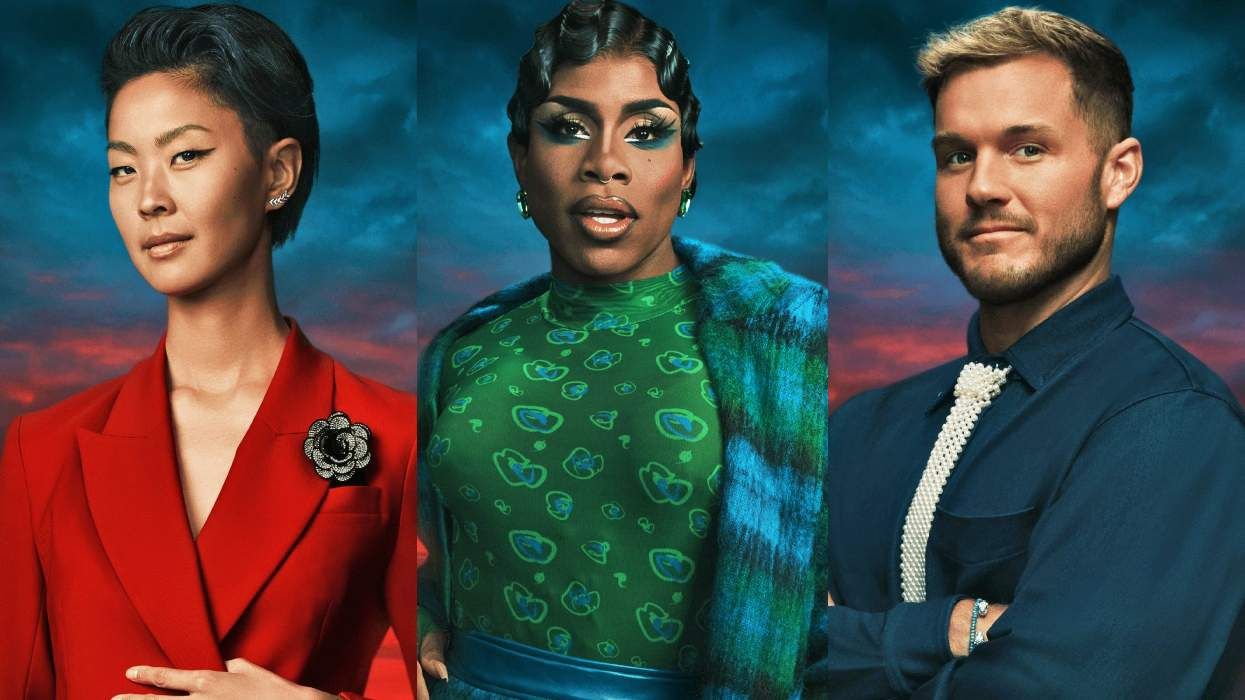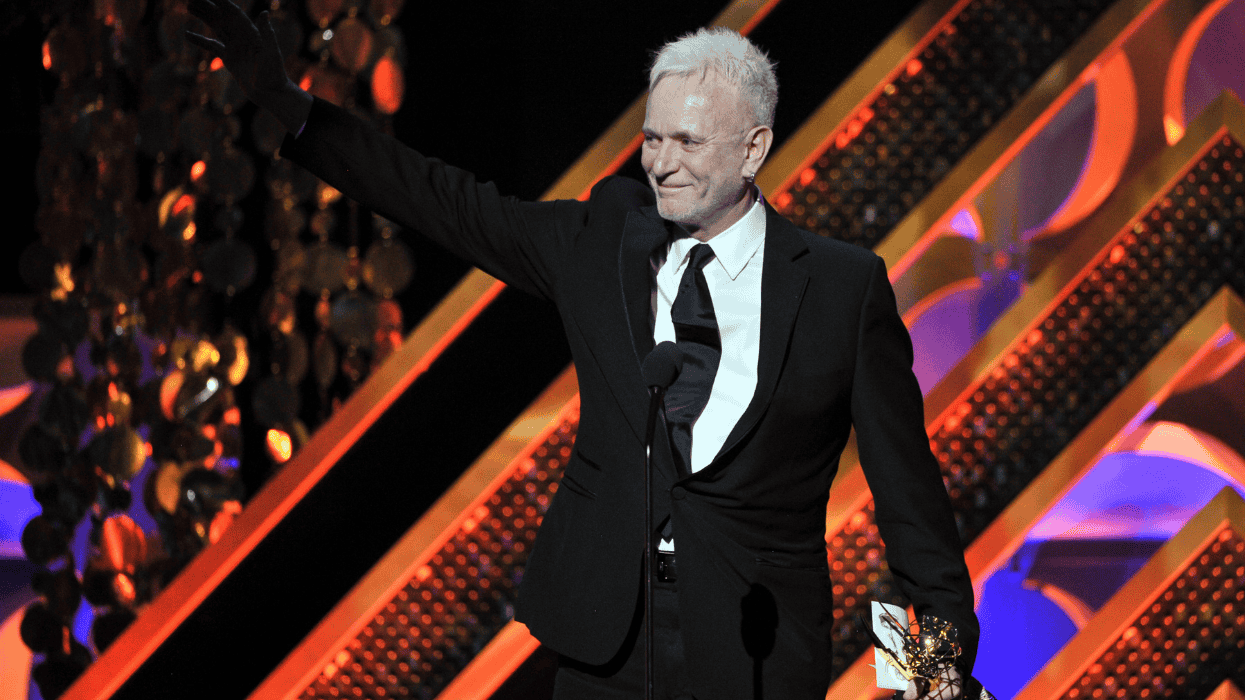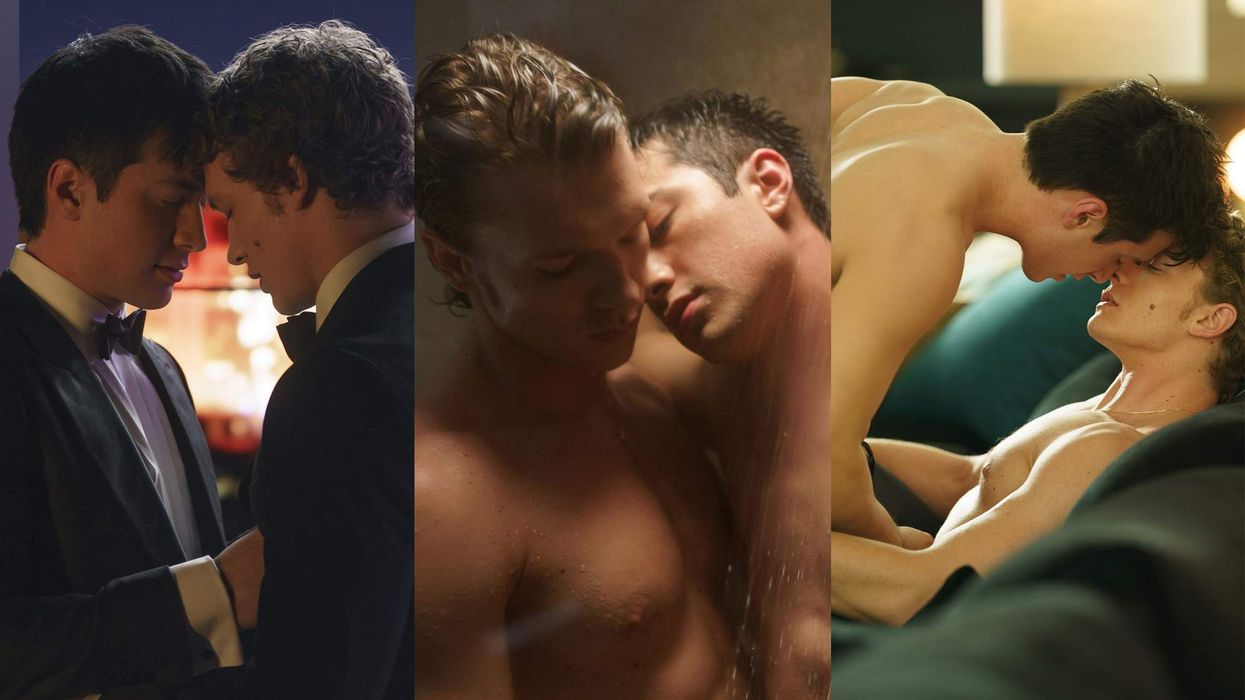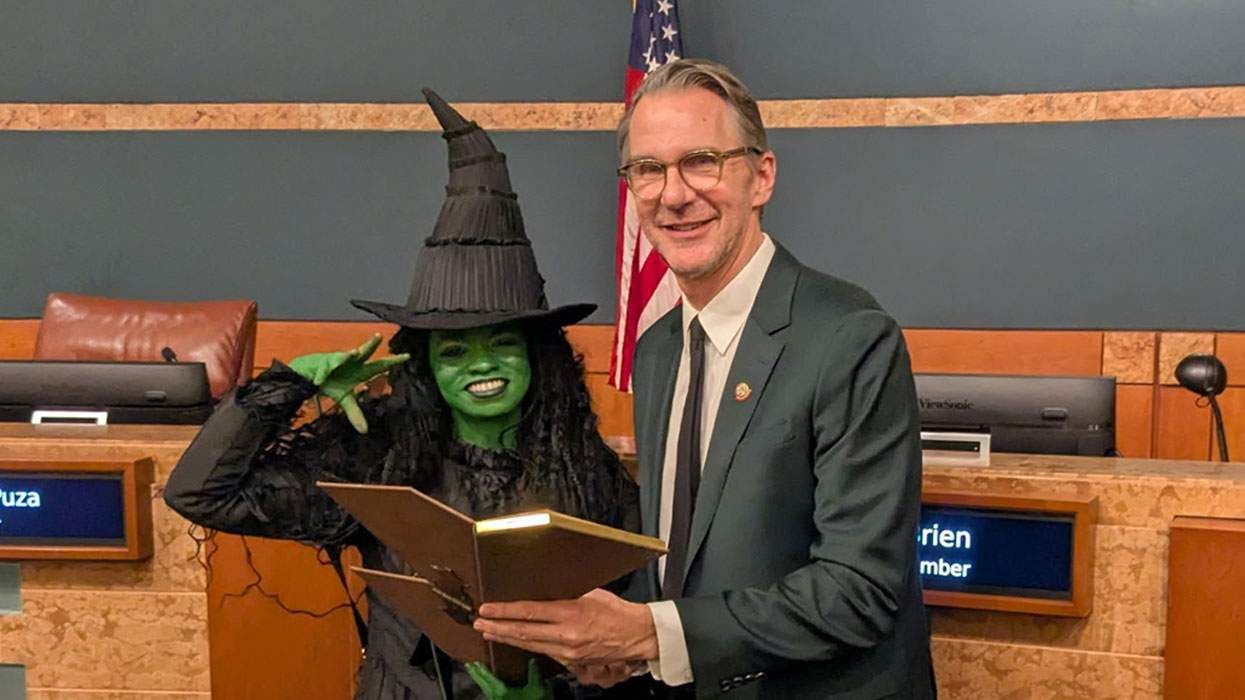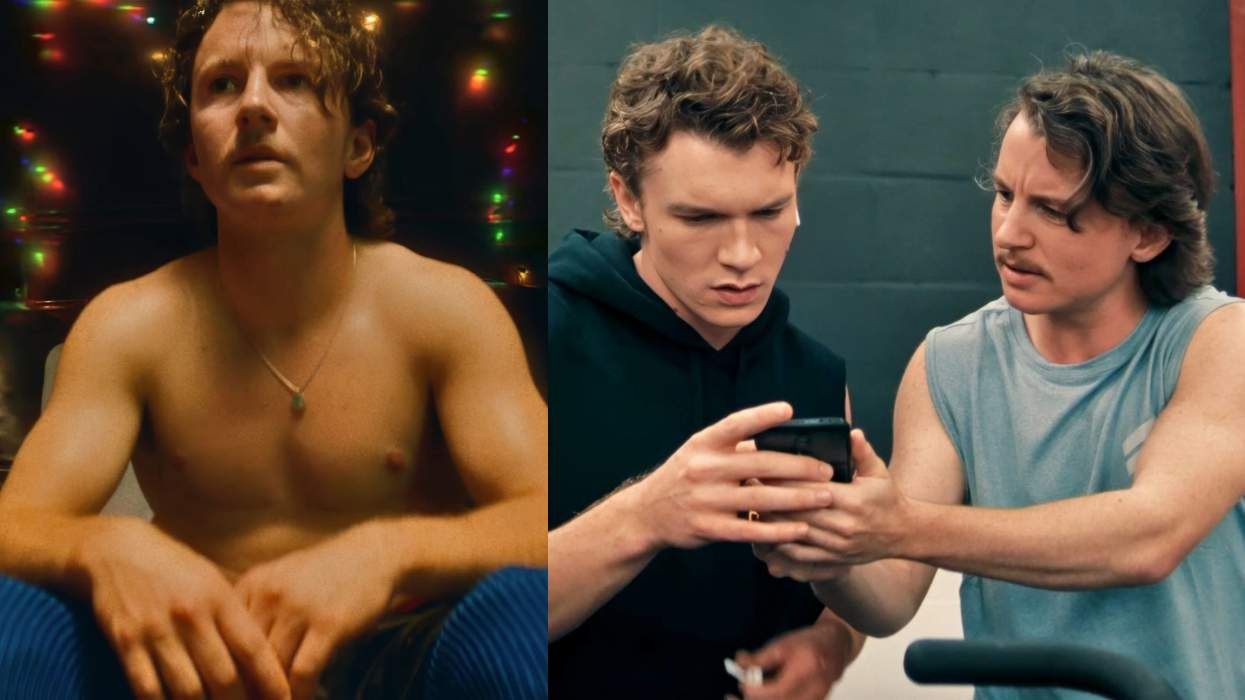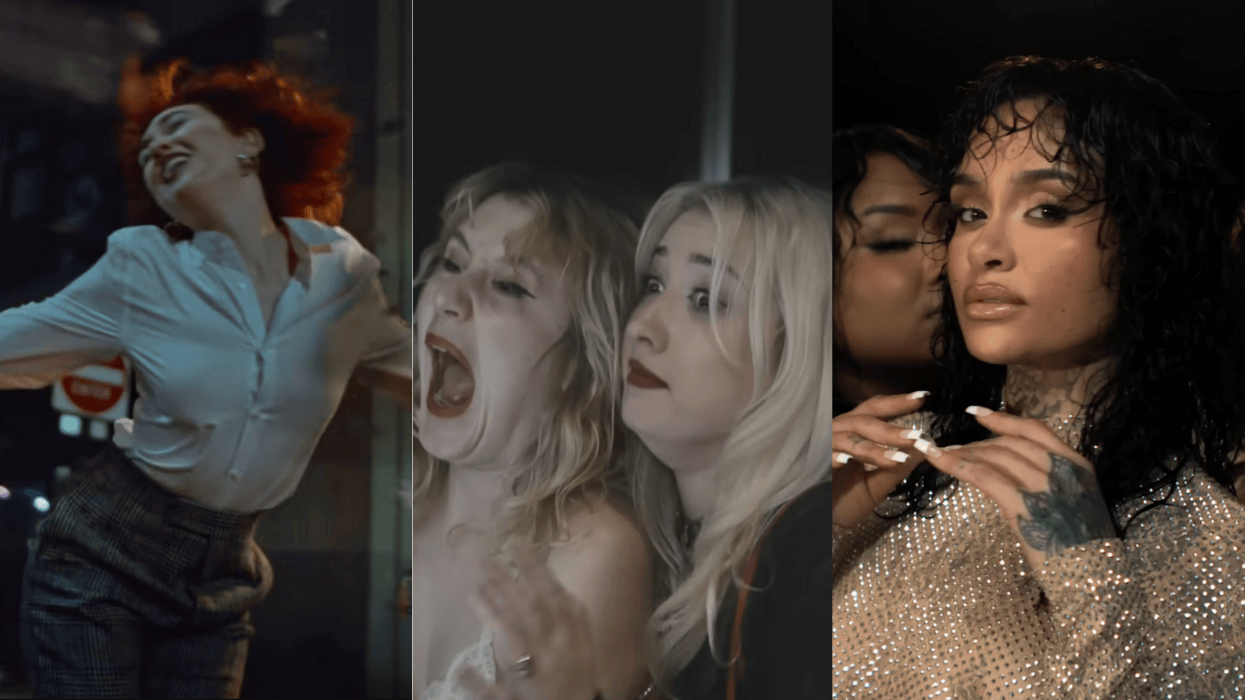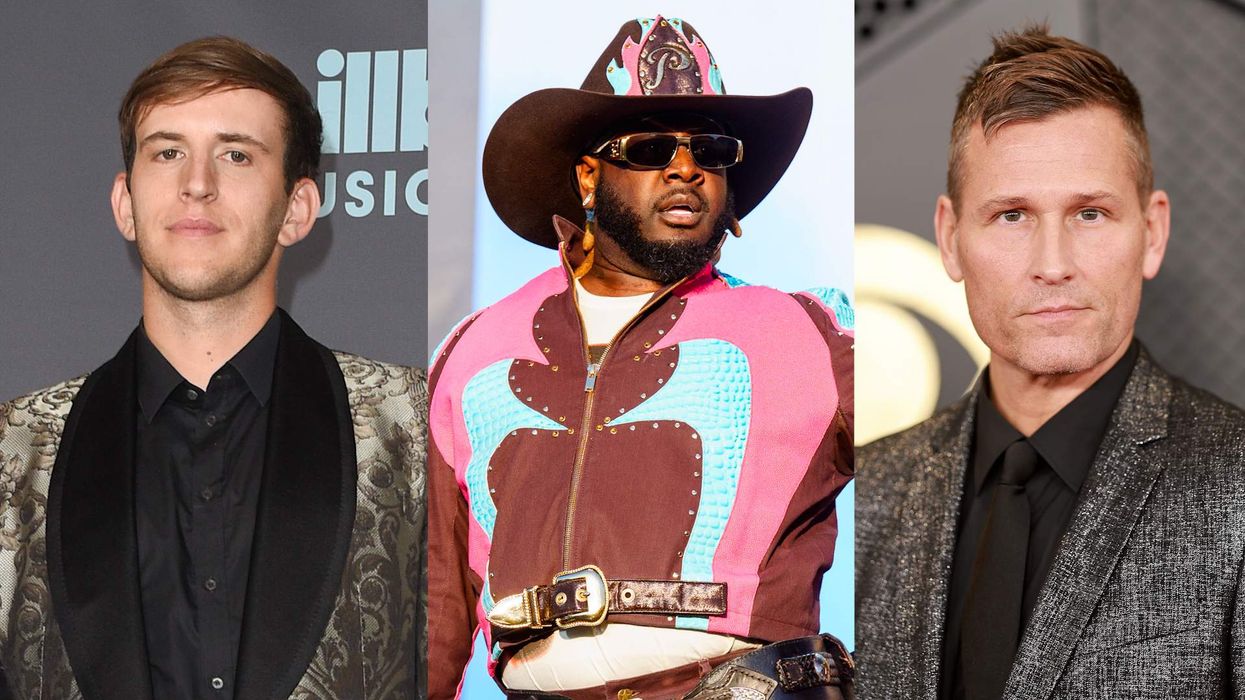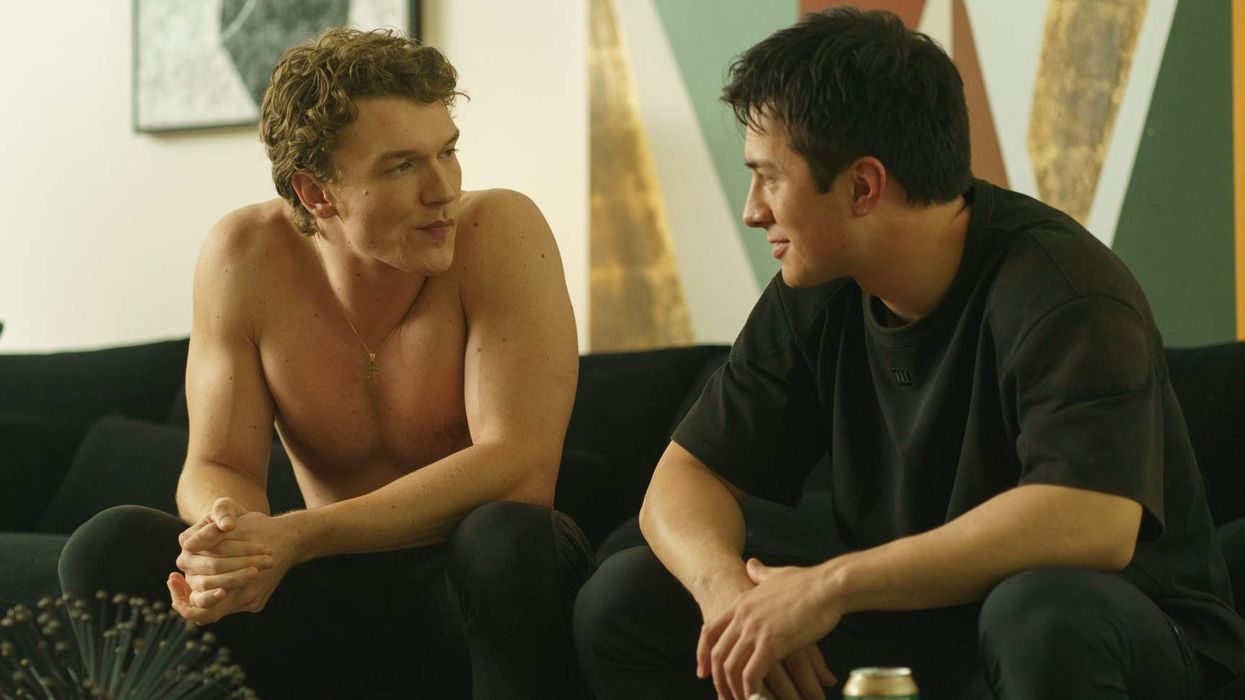Photography by Ryan Pfluger
On a crisp November morning in Secaucus, N.J., there's a nervous bustle inside the Meadowlands Exposition Center, where, just outside, thousands of screaming teenage girls grow restless. At 10 a.m., the doors fling open, the security guards brace themselves, and a tsunami of furry boots, mousy hair, and sparkling orthodontics washes through the hallways.
They swarm the main stage where, in a half hour, a panel will convene under the theme "I Came Out on YouTube." On that panel, Tyler Oakley, a veritable supernova in a jar, sits cross-legged on the sofa, guru-like. He's gracious to the other four panelists, pretending all eyes aren't on him, which is to say, being his usual charming self.
Oakley did not come out on YouTube, so when it's his turn to speak, he tells the audience he is, in fact, gay, which they all already knew. The comment triggers a burst of screams that echo through the rafters of the convention hall, a pitchy, warbling sound that will return about every three minutes for the duration of Playlist Live Tri-State, the event that has brought us all here.
Playlist Live Tri-State gathers dozens of famous YouTube personalities to interact with fans over three days. It's part of a growing number of such conferences spreading across the world and is as much a celebration of a shared interest -- video blogging -- as an homage to YouTube itself.
"My experience was shitty, but now I found YouTube and I feel a lot better," panelist Hannah Hart (7.1 million subscribers on YouTube) tells the audience about coming out as a lesbian. Hart's specialty is cooking while drunk.
"I think YouTube is a platform for authenticity," says 19-year-old YouTuber Troye Sivan (3.1 million subscribers), who's sitting next to Oakley. "We see this aspect of you that you feel courageous enough to share with us. In a way, YouTube is uniquely positioned for that authenticity -- that realness that you guys so beautifully serve."
Tyler Oakley is 25 years old and from Michigan. After studying communication at Michigan State University, he moved to San Francisco, where he ran social media operations for Web sites. Seven years ago, at 18, he uploaded his first video to YouTube, a greeting card sent out to a handful of friends. It attracted around 100 unintended views, and he felt encouraged to make another. Today, he has more than 6 million subscribers on his YouTube channel, plus 3.5 million followers on Twitter, 3.1 million on Instagram, 2.3 million on Facebook, and 1.1 million on Vine (as of press time). His channel is ranked by SocialBlade as the 109th most popular on YouTube.
At 5-foot-5, with a pink complexion, glasses, a small but meaty frame, and spider-silk blonde hair currently dyed pastel blue, Oakley is a vision of the adorable, non-threatening gay best friend. He has a disarming lisp. When he meets fans, he takes them by the arm and looks them in the eye. He finds something about them to compliment ("I love that shirt!"). He thanks them for being their special selves. He tells them he loves them. They hug. They take a selfie. He signs their phones with a Sharpie.
"He's perfect. He's the funniest person. He's, like, real," says one Oakley fan, a 16-year-old girl from New Jersey, standing outside the metal barricades of a meet and greet on Sunday (she couldn't get a ticket). "I feel like a lot of YouTubers are too celebrity-like, but you can relate to Tyler. He's just perfect," she says again, her eyes welling.
He's also credited with giving countless young people the courage to come out of the closet, or to move beyond their small-minded communities. Last year, he raised more than half a million dollars for the Trevor Project, a youth suicide prevention organization.
"Tyler's been an inspiration to me," says Patrick Tanella, a 17-year-old from New Jersey accompanied by a friend at the conference. "He does a lot of social change and advocacy. He's not just like Viners, who don't really do anything. He's famous for a reason, for being a good person."
It's always sunny in this corner of YouTube. For the two days I'm at Playlist Live, the same themes and buzzwords are repeated by creators and fans alike: "authenticity"; "realness"; "Be yourself"; "You are beautiful"; "You are perfect"; "I love you."
"YouTube is a celebration of individuals. We're YouTubers for being ourselves," the moderator tells the audience. Then she fields questions about her favorite beauty products.
It's teenage self-help -- life coaching for adolescents by people who are also, often, consumer product spokespersons. There is a sense, among this passionate fiefdom, of revolution -- the idea that the conventional celebrity, whom they see as distant and unapproachable, is dead. That traditional media is for their parents. (At one point, a YouTuber tells the audience her favorite food is mac and cheese and they explode in cheers. When she later mentions Beyonce, crickets chirp.)
Never mind that YouTube is owned by Google, the world's most valuable brand. Before I meet with Oakley, I pass through a tent reserved for the talent and their guests. The low lights are red and sexy, and lounge music fogs the air. A half dozen girls in heavy makeup and skimpy outfits huddle by the entrance, covering their midriffs with nervously folded arms. It feels a bit like the underbelly of the convention. Some of the cockier YouTube heartthrobs I've noticed strutting around the center, encircled by flocks of girls with outstretched cell phones, are here on the sofas with their limbs flung out, ranting to groupies in that full-throttle, Bieberish fervor symptomatic of boys in late puberty.
I find Oakley eating a hot dog behind the main stage before his question-and-answer session with production partner and fellow YouTuber Korey Kuhl (pronounced "cool"). For Oakley, 2014 was a banner year. Aside from touring the globe from Singapore to Australia and winning two Teen Choice Awards, he made a video with first lady Michelle Obama and met the president. After two days of greeting fans, Oakley's voice is raspy. He's exhausted, but still wide-eyed and pumped with adrenaline.
"Why are you famous?" I ask.
"I'm very open and honest, and I don't really hold back," Oakley says. "I say whatever's on my mind, and I think maybe people like that. I don't know."
I ask him to define his brand.
"Authentic? Hopefully original. Upbeat? Positive is what I want. Inclusive."
While other YouTubers are branching out, Oakley is not working on a book, TV, or film project. But one day he would like to have a talk show in the style of his icon, Ellen DeGeneres. His content on YouTube consists of talking about pop music and describing what he did that week. He uploads two videos a week to his channel. On Tuesday, he opens fan mail on camera and responds to viewer questions. On Friday, he recaps his week in the style of a video diary.
All YouTube content providers are strictly forbidden by the platform from disclosing how much money they make on the site. But do the math and it becomes clear, despite popular perceptions, that almost no one is getting rich there. The payment scheme involves a convoluted algorithm most creators themselves don't understand. YouTube takes 45% of all revenue generated through ad sales on its site -- it's ad views, not video views, that generate income. To establish a pay rate, the company uses a metric for online advertising called the CPM, or "cost per thousand." For pre-roll ads (videos that appear in front of content), this ranges from a payment of $0.60 to $10 per 1,000 views. If a viewer clicks "Skip Ad," as almost everyone does, this becomes a non-monetized view, meaning it does not count toward the CPM, and no one gets paid anything. Content providers have no control over the ads viewers see, which are largely based on things they've searched for on Google. They are also forbidden from telling viewers to watch and click the ads.
If we assume Oakley has the highest CPM of $10, and that half of his ad views are monetized (meaning, again, viewers watched the complete ad without skipping), then a recent video with 1.4 million views, after YouTube takes its 45% cut, would leave Oakley earning $3,850. If Oakley's CPM is $5, then the number is down to $1,925, or under $4,000 a week for his two-video regimen. Then there are also production costs, manager costs, and agency costs.
[rebelmouse-image 32830271 expand=1 dam=1 alt="Tyler-Oakley" site_id=25879314 is_animated_gif=false original_size="655x819" crop_info="%7B%22image%22%3A%20%22https%3A//assets.rbl.ms/32830271/origin.jpg%22%2C%20%22thumbnails%22%3A%20%7B%22origin%22%3A%20%22https%3A//assets.rbl.ms/32830271/origin.jpg%22%2C%20%22600x300%22%3A%20%22https%3A//rebelmouse.out.com/media-library/eyJhbGciOiJIUzI1NiIsInR5cCI6IkpXVCJ9.eyJpbWFnZSI6Imh0dHBzOi8vYXNzZXRzLnJibC5tcy8zMjgzMDI3MS9vcmlnaW4uanBnIiwiZXhwaXJlc19hdCI6MTY5MTE1MDQ3NH0.cOoe7A2Km3zCY3G-2xnJpw3W6LGttM-95Fx9VB_YmP0/image.jpg%3Fwidth%3D600%26height%3D300%26coordinates%3D0%252C128%252C0%252C365%22%2C%20%22600x200%22%3A%20%22https%3A//rebelmouse.out.com/media-library/eyJhbGciOiJIUzI1NiIsInR5cCI6IkpXVCJ9.eyJpbWFnZSI6Imh0dHBzOi8vYXNzZXRzLnJibC5tcy8zMjgzMDI3MS9vcmlnaW4uanBnIiwiZXhwaXJlc19hdCI6MTY5MTE1MDQ3NH0.cOoe7A2Km3zCY3G-2xnJpw3W6LGttM-95Fx9VB_YmP0/image.jpg%3Fwidth%3D600%26height%3D200%26coordinates%3D0%252C182%252C0%252C419%22%2C%20%2235x35%22%3A%20%22https%3A//rebelmouse.out.com/media-library/eyJhbGciOiJIUzI1NiIsInR5cCI6IkpXVCJ9.eyJpbWFnZSI6Imh0dHBzOi8vYXNzZXRzLnJibC5tcy8zMjgzMDI3MS9vcmlnaW4uanBnIiwiZXhwaXJlc19hdCI6MTY5MTE1MDQ3NH0.cOoe7A2Km3zCY3G-2xnJpw3W6LGttM-95Fx9VB_YmP0/image.jpg%3Fwidth%3D35%26height%3D35%22%2C%20%221500x2000%22%3A%20%22https%3A//rebelmouse.out.com/media-library/eyJhbGciOiJIUzI1NiIsInR5cCI6IkpXVCJ9.eyJpbWFnZSI6Imh0dHBzOi8vYXNzZXRzLnJibC5tcy8zMjgzMDI3MS9vcmlnaW4uanBnIiwiZXhwaXJlc19hdCI6MTY5MTE1MDQ3NH0.cOoe7A2Km3zCY3G-2xnJpw3W6LGttM-95Fx9VB_YmP0/image.jpg%3Fwidth%3D1500%26height%3D2000%26coordinates%3D41%252C0%252C0%252C0%22%2C%20%222000x1500%22%3A%20%22https%3A//rebelmouse.out.com/media-library/eyJhbGciOiJIUzI1NiIsInR5cCI6IkpXVCJ9.eyJpbWFnZSI6Imh0dHBzOi8vYXNzZXRzLnJibC5tcy8zMjgzMDI3MS9vcmlnaW4uanBnIiwiZXhwaXJlc19hdCI6MTY5MTE1MDQ3NH0.cOoe7A2Km3zCY3G-2xnJpw3W6LGttM-95Fx9VB_YmP0/image.jpg%3Fwidth%3D2000%26height%3D1500%26coordinates%3D0%252C46%252C0%252C283%22%2C%20%221245x700%22%3A%20%22https%3A//rebelmouse.out.com/media-library/eyJhbGciOiJIUzI1NiIsInR5cCI6IkpXVCJ9.eyJpbWFnZSI6Imh0dHBzOi8vYXNzZXRzLnJibC5tcy8zMjgzMDI3MS9vcmlnaW4uanBnIiwiZXhwaXJlc19hdCI6MTY5MTE1MDQ3NH0.cOoe7A2Km3zCY3G-2xnJpw3W6LGttM-95Fx9VB_YmP0/image.jpg%3Fwidth%3D1245%26height%3D700%26coordinates%3D0%252C107%252C0%252C344%22%2C%20%22600x%22%3A%20%22https%3A//rebelmouse.out.com/media-library/eyJhbGciOiJIUzI1NiIsInR5cCI6IkpXVCJ9.eyJpbWFnZSI6Imh0dHBzOi8vYXNzZXRzLnJibC5tcy8zMjgzMDI3MS9vcmlnaW4uanBnIiwiZXhwaXJlc19hdCI6MTY5MTE1MDQ3NH0.cOoe7A2Km3zCY3G-2xnJpw3W6LGttM-95Fx9VB_YmP0/image.jpg%3Fwidth%3D600%22%2C%20%22210x%22%3A%20%22https%3A//rebelmouse.out.com/media-library/eyJhbGciOiJIUzI1NiIsInR5cCI6IkpXVCJ9.eyJpbWFnZSI6Imh0dHBzOi8vYXNzZXRzLnJibC5tcy8zMjgzMDI3MS9vcmlnaW4uanBnIiwiZXhwaXJlc19hdCI6MTY5MTE1MDQ3NH0.cOoe7A2Km3zCY3G-2xnJpw3W6LGttM-95Fx9VB_YmP0/image.jpg%3Fwidth%3D210%22%2C%20%221000x750%22%3A%20%22https%3A//rebelmouse.out.com/media-library/eyJhbGciOiJIUzI1NiIsInR5cCI6IkpXVCJ9.eyJpbWFnZSI6Imh0dHBzOi8vYXNzZXRzLnJibC5tcy8zMjgzMDI3MS9vcmlnaW4uanBnIiwiZXhwaXJlc19hdCI6MTY5MTE1MDQ3NH0.cOoe7A2Km3zCY3G-2xnJpw3W6LGttM-95Fx9VB_YmP0/image.jpg%3Fwidth%3D1000%26height%3D750%26coordinates%3D0%252C46%252C0%252C283%22%2C%20%22700x1245%22%3A%20%22https%3A//rebelmouse.out.com/media-library/eyJhbGciOiJIUzI1NiIsInR5cCI6IkpXVCJ9.eyJpbWFnZSI6Imh0dHBzOi8vYXNzZXRzLnJibC5tcy8zMjgzMDI3MS9vcmlnaW4uanBnIiwiZXhwaXJlc19hdCI6MTY5MTE1MDQ3NH0.cOoe7A2Km3zCY3G-2xnJpw3W6LGttM-95Fx9VB_YmP0/image.jpg%3Fwidth%3D700%26height%3D1245%26coordinates%3D155%252C0%252C40%252C0%22%2C%20%221200x400%22%3A%20%22https%3A//rebelmouse.out.com/media-library/eyJhbGciOiJIUzI1NiIsInR5cCI6IkpXVCJ9.eyJpbWFnZSI6Imh0dHBzOi8vYXNzZXRzLnJibC5tcy8zMjgzMDI3MS9vcmlnaW4uanBnIiwiZXhwaXJlc19hdCI6MTY5MTE1MDQ3NH0.cOoe7A2Km3zCY3G-2xnJpw3W6LGttM-95Fx9VB_YmP0/image.jpg%3Fwidth%3D1200%26height%3D400%26coordinates%3D0%252C182%252C0%252C419%22%2C%20%22600x400%22%3A%20%22https%3A//rebelmouse.out.com/media-library/eyJhbGciOiJIUzI1NiIsInR5cCI6IkpXVCJ9.eyJpbWFnZSI6Imh0dHBzOi8vYXNzZXRzLnJibC5tcy8zMjgzMDI3MS9vcmlnaW4uanBnIiwiZXhwaXJlc19hdCI6MTY5MTE1MDQ3NH0.cOoe7A2Km3zCY3G-2xnJpw3W6LGttM-95Fx9VB_YmP0/image.jpg%3Fwidth%3D600%26height%3D400%26coordinates%3D0%252C73%252C0%252C310%22%2C%20%22300x300%22%3A%20%22https%3A//rebelmouse.out.com/media-library/eyJhbGciOiJIUzI1NiIsInR5cCI6IkpXVCJ9.eyJpbWFnZSI6Imh0dHBzOi8vYXNzZXRzLnJibC5tcy8zMjgzMDI3MS9vcmlnaW4uanBnIiwiZXhwaXJlc19hdCI6MTY5MTE1MDQ3NH0.cOoe7A2Km3zCY3G-2xnJpw3W6LGttM-95Fx9VB_YmP0/image.jpg%3Fwidth%3D300%26height%3D300%26coordinates%3D0%252C0%252C0%252C165%22%2C%20%22300x%22%3A%20%22https%3A//rebelmouse.out.com/media-library/eyJhbGciOiJIUzI1NiIsInR5cCI6IkpXVCJ9.eyJpbWFnZSI6Imh0dHBzOi8vYXNzZXRzLnJibC5tcy8zMjgzMDI3MS9vcmlnaW4uanBnIiwiZXhwaXJlc19hdCI6MTY5MTE1MDQ3NH0.cOoe7A2Km3zCY3G-2xnJpw3W6LGttM-95Fx9VB_YmP0/image.jpg%3Fwidth%3D300%22%2C%20%221200x600%22%3A%20%22https%3A//rebelmouse.out.com/media-library/eyJhbGciOiJIUzI1NiIsInR5cCI6IkpXVCJ9.eyJpbWFnZSI6Imh0dHBzOi8vYXNzZXRzLnJibC5tcy8zMjgzMDI3MS9vcmlnaW4uanBnIiwiZXhwaXJlc19hdCI6MTY5MTE1MDQ3NH0.cOoe7A2Km3zCY3G-2xnJpw3W6LGttM-95Fx9VB_YmP0/image.jpg%3Fwidth%3D1200%26height%3D600%26coordinates%3D0%252C128%252C0%252C365%22%2C%20%22600x600%22%3A%20%22https%3A//rebelmouse.out.com/media-library/eyJhbGciOiJIUzI1NiIsInR5cCI6IkpXVCJ9.eyJpbWFnZSI6Imh0dHBzOi8vYXNzZXRzLnJibC5tcy8zMjgzMDI3MS9vcmlnaW4uanBnIiwiZXhwaXJlc19hdCI6MTY5MTE1MDQ3NH0.cOoe7A2Km3zCY3G-2xnJpw3W6LGttM-95Fx9VB_YmP0/image.jpg%3Fwidth%3D600%26height%3D600%26coordinates%3D0%252C0%252C0%252C165%22%2C%20%22750x1000%22%3A%20%22https%3A//rebelmouse.out.com/media-library/eyJhbGciOiJIUzI1NiIsInR5cCI6IkpXVCJ9.eyJpbWFnZSI6Imh0dHBzOi8vYXNzZXRzLnJibC5tcy8zMjgzMDI3MS9vcmlnaW4uanBnIiwiZXhwaXJlc19hdCI6MTY5MTE1MDQ3NH0.cOoe7A2Km3zCY3G-2xnJpw3W6LGttM-95Fx9VB_YmP0/image.jpg%3Fwidth%3D750%26height%3D1000%26coordinates%3D41%252C0%252C0%252C0%22%2C%20%221200x800%22%3A%20%22https%3A//rebelmouse.out.com/media-library/eyJhbGciOiJIUzI1NiIsInR5cCI6IkpXVCJ9.eyJpbWFnZSI6Imh0dHBzOi8vYXNzZXRzLnJibC5tcy8zMjgzMDI3MS9vcmlnaW4uanBnIiwiZXhwaXJlc19hdCI6MTY5MTE1MDQ3NH0.cOoe7A2Km3zCY3G-2xnJpw3W6LGttM-95Fx9VB_YmP0/image.jpg%3Fwidth%3D1200%26height%3D800%26coordinates%3D0%252C73%252C0%252C310%22%2C%20%22980x%22%3A%20%22https%3A//rebelmouse.out.com/media-library/eyJhbGciOiJIUzI1NiIsInR5cCI6IkpXVCJ9.eyJpbWFnZSI6Imh0dHBzOi8vYXNzZXRzLnJibC5tcy8zMjgzMDI3MS9vcmlnaW4uanBnIiwiZXhwaXJlc19hdCI6MTY5MTE1MDQ3NH0.cOoe7A2Km3zCY3G-2xnJpw3W6LGttM-95Fx9VB_YmP0/image.jpg%3Fwidth%3D980%22%7D%2C%20%22manual_image_crops%22%3A%20%7B%229x16%22%3A%20%7B%22sizes%22%3A%20%5B%22700x1245%22%5D%2C%20%22top%22%3A%200%2C%20%22height%22%3A%20819%2C%20%22width%22%3A%20460%2C%20%22left%22%3A%20155%7D%2C%20%22600x300%22%3A%20%7B%22sizes%22%3A%20%5B%22600x300%22%5D%2C%20%22top%22%3A%20128%2C%20%22height%22%3A%20326%2C%20%22width%22%3A%20655%2C%20%22left%22%3A%200%7D%2C%20%223x1%22%3A%20%7B%22sizes%22%3A%20%5B%221200x400%22%2C%20%22600x200%22%5D%2C%20%22top%22%3A%20182%2C%20%22height%22%3A%20218%2C%20%22width%22%3A%20655%2C%20%22left%22%3A%200%7D%2C%20%223x2%22%3A%20%7B%22sizes%22%3A%20%5B%221200x800%22%2C%20%22600x400%22%5D%2C%20%22top%22%3A%2073%2C%20%22height%22%3A%20436%2C%20%22width%22%3A%20655%2C%20%22left%22%3A%200%7D%2C%20%221x1%22%3A%20%7B%22sizes%22%3A%20%5B%22600x600%22%2C%20%22300x300%22%5D%2C%20%22top%22%3A%200%2C%20%22height%22%3A%20654%2C%20%22width%22%3A%20655%2C%20%22left%22%3A%200%7D%2C%20%223x4%22%3A%20%7B%22sizes%22%3A%20%5B%221500x2000%22%2C%20%22750x1000%22%5D%2C%20%22top%22%3A%200%2C%20%22height%22%3A%20819%2C%20%22width%22%3A%20614%2C%20%22left%22%3A%2041%7D%2C%20%2216x9%22%3A%20%7B%22sizes%22%3A%20%5B%221245x700%22%5D%2C%20%22top%22%3A%20107%2C%20%22height%22%3A%20368%2C%20%22width%22%3A%20655%2C%20%22left%22%3A%200%7D%2C%20%224x3%22%3A%20%7B%22sizes%22%3A%20%5B%222000x1500%22%2C%20%221000x750%22%5D%2C%20%22top%22%3A%2046%2C%20%22height%22%3A%20490%2C%20%22width%22%3A%20655%2C%20%22left%22%3A%200%7D%2C%20%222x1%22%3A%20%7B%22sizes%22%3A%20%5B%221200x600%22%2C%20%22600x300%22%5D%2C%20%22top%22%3A%20128%2C%20%22height%22%3A%20326%2C%20%22width%22%3A%20655%2C%20%22left%22%3A%200%7D%7D%7D" caption=""I'm very open and honest, and I don't really hold back," Oakley says. "I say whatever's on my mind, and I think maybe people like that. I don't know." \nREAD THE STORY" photo_credit=""]
It's not a bad take-home. But for someone with a healthy, though not superstar, fan base, the payout can be quite dismal. Kuhl has about 60,000 subscribers and averages some 20,000 to 30,000 views per video. Assuming an optimistic CPM of $5, and assuming -- again, quite optimistically -- that half his viewers don't opt to skip the pre-roll ad, a video with 30,000 views, taking into account the above metrics, and after YouTube's cut, will bring Kuhl a paycheck of $41.25.
YouTube can't touch the money that Oakley and others make by promoting products within the content of their videos -- so-called "sponsored videos," even if they're not always disclosed as such. In one video, Oakley begins, "Y'all recently asked how I get ready in the morning." In the ensuing nine minutes he promotes 13 different products and companies -- many of them hair-related -- as a part of his morning routine.
When I watched the video recently, an unskippable pre-roll ad for Taco Bell played. Doritos (a PepsiCo product) and Taco Bell (owned by PepsiCo spin-off Yum!) have a special relationship with Oakley. He gives them shout-outs every so often. Oakley says he also provided the inspiration for Taco Bell's recent line of Cool Ranch Doritos Locos tacos.
Viewers watch more than 300 million hours of video on YouTube each day, and YouTube banked about $1.1 billion in ad revenue in 2014 (CBS, by comparison, made nearly $9 billion). In New York City, several subway trains popped up recently, covered entirely, inside and out, in ads for YouTubers -- bright-faced things who bake cookies or give makeup lessons. The ads are creepy, even by New York subway standards.
This is part of YouTube's new bid to scale the chasm between Silicon Valley and Hollywood, and turn its celebrities into real celebrities. YouTube also now advertises on traditional television.
YOU MAKE IT SWEET TO BE YOURSELF, reads one ad.
YOU FIGHT BULLIES WITH STYLE, reads another.
YOU MAKE CONFIDENCE THE MUST-HAVE ACCESORY.
These are mantras that might have been spoken in real time by YouTubers on the stage in New Jersey, nearly all of whom were enthusiastic to recruit You to connect and live the life.
"If you have your own voice, you should join YouTube and tell your own story," Oakley tells the audience at Playlist Live. "You never know who is watching, or the ripple effect you might have by sharing your story. Somebody might find it and see themselves in just you, nobody else."
"Stop watching us, and start doing your own thing," urges YouTuber Davey Wavey (800,000 subscribers). "And we will tune in. We will watch it."
Sadie Squillaciotti, a 14-year-old from Pennsylvania, strutted around the convention center with her face autographed in Sharpie by a few dozen YouTubers. "They're down-to-earth. They're not like rich people," she says. "I just started making my own videos. I'm in a collab. This is only our second week."
These fans grow on you. They are, at the core, pretty nerdy. Teen-girl followings -- with roots in the bobby-soxers, Elvis, and Beatlemania -- continue to be ridiculed, often dismissed as having good ol' fashioned female hysteria.
In reality, the innocuousness of the pop culture content the fans worship is probably not what all the screaming is about. Academic literature talks of female bonding and how fandom is a release from the stringent rules placed on girls as they develop sexually.
"I think it comes from a healthy place for teenagers. They're just looking to connect with people," Oakley says, "and you don't see homophobia in YouTube culture at all -- they love the gays." Sometimes, he adds, they love the gays a little too much. Some girls have been known to send him racy fan fiction. A few weeks later, I reunite with Oakley and Kuhl in Los Angeles. They met at Michigan State, shared an apartment in San Francisco for some years, and now live a few blocks from each other in West Hollywood. Kuhl, who turns 30 this spring, studied creative writing and worked a miserable job as a loan officer at a commercial bank when Oakley tapped him to be a production partner in his YouTube enterprise. In 2014, the two started a weekly podcast called Psychobabble.
We're having lunch at a cheap sushi restaurant inside a shopping center off Santa Monica Boulevard when I tell the duo how surprised I am that so much can change in less than a generation.
"All my teen idols committed suicide or died of AIDS," I say, followed by a bewildered silence from across the table. Oakley looks at me with probing sorrow.
"OK, on a lighter note..." Kuhl says.
After another beat, Oakley bursts into sardonic, belly-rolling laughter, giving me hope that I've cracked the shell and our conversation may turn wry. For Oakley, the line between work and personal life is a fine one. "This is my hobby. This is my fun. Whatever I do for fun, my instinct is to run back to my house and talk about it on camera," he says.
He's more relaxed here on his adopted home turf while continuing to sell that magnetism that's made him famous online: He's giggly, upbeat, warm. A best friend. An ear. He's wearing a hoodie, and his hair is unwashed. Oakley and Kuhl are seated in the farthest booth of the restaurant, Oakley slumped low against the wall, avoiding any girls who might pass by on the street and catch sight of their blue-haired beacon. They've just come off a seven-city tour with Tyler Oakley's Slumber Party -- it's what it sounds like -- and Kuhl has a new boyfriend; they met on Grindr. For Oakley, dating is weird territory. On hookup apps, he's never sure why people are contacting him. They won't always say if they recognize who he is. He questions their motivations and finds conversation with men his own age difficult.
"And how do I explain going on tour to non-YouTube people?" Oakley says. "That I'll be onstage in a onesie? They're like, 'Is it stand-up?' and I'm like, 'It's kind of a variety show, like an Ellen-meets-Pee-wee's-Playhouse slumber party.' And they're like, 'Do people come?' "
Of the YouTubers I meet, Kuhl seems the most out of place. He is, by YouTuber standards, relatively old. He gets flustered and is inclined to introversion. He sometimes is mystified by the whole cult of YouTube.
"It's funny. I never thought I was going to be 29 years old and travel on a tour bus where I literally wore an animal onesie onstage seven nights in a row and hugged 150 kids, every day, and took pictures with them," he says.
Earlier, I was in a studio overlooking the 101, watching the two record an episode of Psychobabble, and was struck by one of Oakley's throwaway phrases, his "passion for YouTube." At lunch, he tells me what makes YouTube special: the thrill of seeing others in the community rise to fame.
This may be true. More accurately, as with anyone who pursues fame, watching oneself rise is probably more thrilling. The consumer product sold on YouTube isn't music or fashion; it's connectedness. It's the passion for marketing oneself and an infatuation with acceptance.
"No one is above anyone else in the YouTube community," Oakley says. "I'm right there with you, and there's no hierarchy. I want this to be a space that's safe, supportive, and productive. That's the mentality I try to foster. I don't know about the other YouTubers."
For Oakley, as for all YouTubers, the future is unclear. As fast as the Internet creates celebrities, it even more quickly tears them down or, worse, forgets about them. It gets awkward when I bring this up.
"I like the feeling of being competitive with myself. I'm fortunate that I love my business. It allows me to be myself, and people are attracted to that. But I do treat it professionally, and I do approach everything from a business standpoint," Oakley says.
The bottom line of marketing is deception. When you sell something as being "real," what are you selling? If there's another side to Oakley, we are not going to see it. Oakley masterfully guards those things about himself that are complex, easily misunderstood, and ripe for exploitation.
In the ruthlessly optimistic universe we call social media, where personal branding is a blood sport, who wouldn't?


